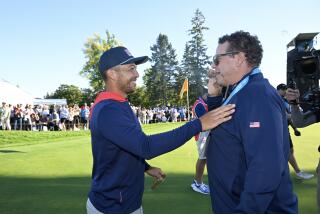Will America’s Cup Create a Ripple? : Event Timing Will Dictate Limits on Media Coverage
- Share via
SAN DIEGO — John Curley, sports editor of the San Francisco Chronicle, has this nightmare and it goes like this: “I’m afraid of being faced with a situation where we have a headline, ‘Conner Loses the America’s Cup, See Page 5.’ ”
He is not alone, as sports editors throughout the country try to gauge where the America’s Cup races in San Diego between New Zealander Michael Fay and American Dennis Conner fit on a plate brimming with athletic fare.
Sailing’s most prestigious contest, scheduled to begin Sept. 7, has the misfortune of being just one more item on a list that already makes September one of the busiest times of the year for U.S. newspaper sports staffs. Competing for attention will be college and pro football, baseball division title races; the U.S. Open tennis tournament and the Olympic Games, which start Sept. 17.
“The timing is just brutal,” said Bill Knight, sports editor of the Seattle Post-Intelligencer, which covers an area rich in sailing tradition. “We’ve got the (National Football League’s) Seahawks, the (University of Washington) Huskies, two of our people will be at the Olympics . . . We’re stretched pretty thin.”
To varying degrees, it’s a refrain being repeated in newsrooms big and small throughout the land. But linked to the question of how newspapers and other media will cover the America’s Cup is a more subtle issue.
When Conner won back the Cup in Fremantle last year, millions of Americans stayed awake into the wee hours, watching live television coverage of the event provided by cable network ESPN. For a sport that traditionally was associated with the rich and the elite, the impact was both surprising and positive.
It certainly appeared that the Cup races struck a harmonious chord with America’s middle-class sports fans, folks who know their baseball and football but who probably wouldn’t recognize a spinnaker from a halyard. What they know and appreciate, though, is an athletic contest, especially one heightened by nationalistic overtones.
At stake, this time, is whether September’s weeklong one-on-one match race--supplanting a months-long multinational regatta--will again attract the U.S. neophyte Cup fan, who, race officials say, is critical to the long-range future of the sport.
And that’s where the information middlemen come into play.
“The whole ridiculous nature that it’s been has cooled our ardor for it a little bit,” said Bill Griffith, assistant sports editor of the Boston Globe, who noted that reaction among his paper’s readers--many of whom are sailing buffs--to this America’s Cup so far has been “total apathy.”
“Usually we get complaints from sailing people that we’re not doing enough coverage,” Griffith said. But now, he suspects, “they see gamesmanship as opposed to athletics.”
Almost from the moment the Cup returned to the United States last year, the event has been wrapped in confusion, controversy and chaos. First there were long and bitter discussions between the San Diego Yacht Club and Sail America over where the defense would be held, a matter that wasn’t settled until after an arbitrator was brought in to calm the fray.
Then there was Fay’s unprecedented challenge, which further muddled matters for months as the issue reverberated in a New York courtroom, bringing to public attention the arcane rules and regulations that govern the race.
Only a few weeks ago, a New York judge finally cleared the way for the race to go ahead, and the dates for the contest were finally set.
Like most other editors, Griffith thinks the Cup story will rate front-page play in the sports section for the first race. But if it turns out to be a one-sided drubbing by Conner’s catamaran over the Kiwis’ monohull? “Then it will be difficult to get the second race on the page.”
The Globe, which sent two reporters and a photographer to Fremantle in 1987, will cover the match with one sportswriter. Normally, Griffith said, he would send a columnist as well, but the confusing nature and late scheduling of the contest preempted that option.
People at the Sail America Foundation, the organization putting on the races, and in the Stars & Stripes syndicate are well aware of what they’re up against.
As recently as July, officials at Sail America were saying that they expected as many as 3,100 reporters to cover the competition. But it has become apparent that the number of reporters, both from the United States and abroad, will be closer to 700.
“A lot of papers have said that they’ll just pick up (coverage of the race from) UPI and AP stories,” said Tom Mitchell, spokesman for Sail America and a former television news director at a San Diego station. “We won’t have the whole mass group” of international reporters that accompanied the regatta last year in Australia.
The main reason for that, say officials, is that last year the nations competing for the Cup--Italy, Britain, France, Canada and five U.S. entries--were accompanied by reporters from those countries. But with the contest this year between one boat from New Zealand and one boat from the United States, many of them decided to stay home.
Those reporters who do end up here will find themselves at the old police station on Market Street, part of which is being renovated into the “Louis Vuitton America’s Cup Media Centre.” The company is spending about $500,000 to remodel and operate the new center, which will contain a 17,000-square-foot working press area, an outdoor cafe and a press conference area in the station’s old courtyard.
Racing will begin Wednesday, Sept. 7, with the second race on Friday and the final race, if necessary, on Sunday. The unusual midweek start can be traced both to the competition from other sports and the dictates of television.
“This is primarily a television event,” Mitchell said. The current tentative course 20 miles out to sea will make it difficult for spectators to watch the races other than on TV, even on the 3,000 to 4,000 boats expected in town to view the contest.
ESPN, which won accolades for its coverage from Fremantle, will again televise the competition. The cable network has begun Monday night shows aimed at both previewing and promoting the race.
The network hopes that its production, which is to include multiple cameras and microphones on the boats, as well as camera shots from helicopters, will be so good that it will entice fans who may be turned off by the off-water legal war and uncertainties that have dogged the event.
“It’s been difficult to gauge, up to this point, the interest in this because it’s been so uncertain,” said Chris La Placa, spokesman for the network. “We haven’t had a whole lot of time to develop a (Cup) series, particularly when compared to something we’ve known is definitely going to happen for some time.
“The thing is, we don’t have a whole series of documentaries and profiles and previews working up to the finals. We just have the finals, and they could be over in two races. In Fremantle, we had six to eight months of strong buildup and thus the audience had an awareness. So to that extent, there are some inherent disadvantages.”
But La Placa and Cup officials believe that this contest has received so much publicity--from the courtroom to the vast differences between the two vessels--that most sports fans are aware that the race is definitely on.
“I think there will be such sheer curiosity about the boats and that will win the day, and people will find it very exciting,” said Lesleigh Green of the Stars & Stripes military publication. “I think there’s a lot more interest in this than even we thought,” she said, explaining that last the syndicate recently held an unadvertised open house and 7,000 people showed up to look at and touch the boats and the fixed-wing sail on one of the catamarans.
It does seem clear that media interest in the contest centers on the disparate design of the two crafts.
Curley, the Chronicle editor, has a similar concern, and that has to do with the best-of-three format.
“The preliminaries, which you don’t have this time, help build the drama,” he said. “Our concern is that the catamaran will have won and everything will be done and over with before people get a chance to get acquainted with the event again.”
Curley said his paper is sending its sailing writer and probably a photographer, but had there been more time to plan and budget resources better it would have augmented them with another writer or a columnist.
For when it comes to fall, Curley and his colleagues readily acknowledge, it is necessary to serve readers’ major interest, and that’s football.
“Nothing rivals interest in the 49ers in this area,” he said. “If this match comes down to a Sunday and this casual fan watching the America’s Cup or the 49ers, a great number of these fans will take the 49ers over the beautiful yachts in San Diego.”
If that’s the case, in an area with a strong nautical following, such as San Francisco, it is even more prevalent in places such as Dallas.
“We’re in a real dilemma,” said Dave Smith, deputy managing editor of the Dallas Morning News. “Usually there’d be no doubt we’d cover it. But it seems to fall on the bottom of the list right now. We would have covered it in November or August, but there couldn’t be a worse time for us than September and October.
“People here, the last thing on their minds in September is the America’s Cup. . . . It’s the Cowboys and college football that they’re thinking about.” That’s not to say that people in Dallas are blase about the Cup. Last year, when Conner was regaining the Cup, Smith said, the paper received a lot of feedback about its coverage, but that so far this year, there is no evidence of rekindled Cup interest.
“The America’s Cup is a lot like Wimbledon and the Kentucky Derby, where people get caught up in it because of the tradition,” he said. “But now that tradition, because of all the troubles surrounding the Cup, is being taken away.
“The Conner folks are trying to appeal to a broader-based following, but these type of people don’t understand all the confusion over a catamaran and a monohull. The people who understand this are really the sailing experts, and there’s not a whole lot of them in Dallas.”
More to Read
Go beyond the scoreboard
Get the latest on L.A.'s teams in the daily Sports Report newsletter.
You may occasionally receive promotional content from the Los Angeles Times.






